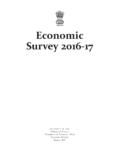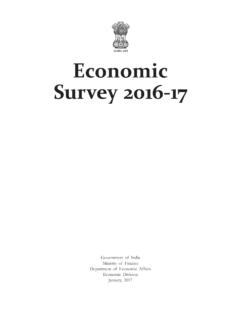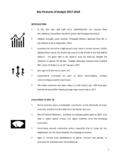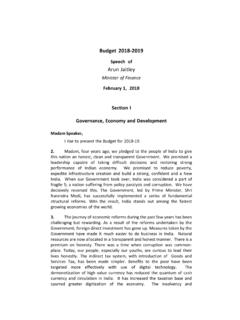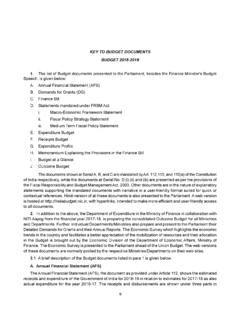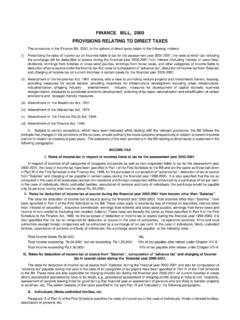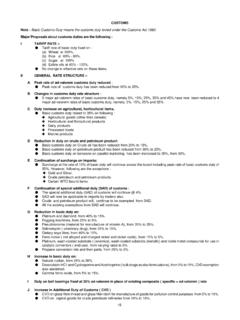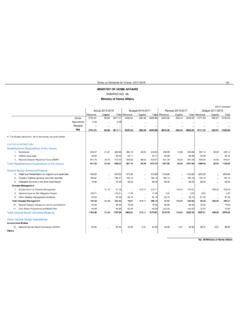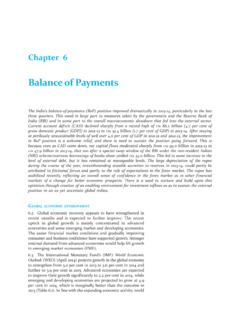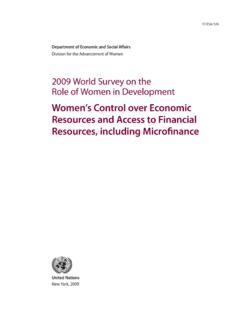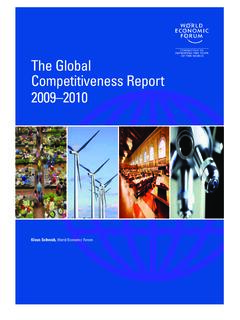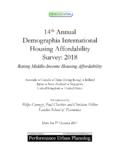Transcription of Saving Lives and Livelihoods Amidst a Once-in-a-Century ...
1 Saving Lives and Livelihoods 01. Amidst a Once-in-a-Century Crisis CHAPTER.. Saving a life that is in jeopardy is the origin of dharma Mahabharata (Shanti parva), Chapter 13, Shloka 598. The Covid-19 pandemic engendered a Once-in-a-Century global crisis in 2020 a unique recession where 90 per cent of countries are expected to experience a contraction in GDP. per capita. Faced with unprecedented uncertainty at the onset of the pandemic, India focused on Saving Lives and Livelihoods by its willingness to take short-term pain for long- term gain. India's response stemmed from the humane principle advocated eloquently in the Mahabharata that Saving a life that is in jeopardy is the origin of dharma. Therefore, India recognised that while GDP growth will recover from the temporary shock caused by the pandemic, human Lives that are lost cannot be brought back.
2 The response drew on epidemiological and economic research, especially those pertaining to the Spanish Flu, which highlighted that an early, intense lockdown provided a win-win strategy to save Lives , and preserve Livelihoods via economic recovery in the medium to long-term. The strategy was also motivated by the Nobel-Prize winning research in Hansen & Sargent (2001) that recommends a policy focused on minimising losses in a worst case scenario when uncertainty is very high. Faced with an unprecedented pandemic and the resultant uncertainty, loss of scores of human Lives captured thus the worst-case scenario. This strategy was also tailored to India's unique vulnerabilities to the pandemic. First, as the pace of spread of a pandemic depends upon network effects, a huge population inherently enables a higher pace of spread.
3 Second, as the pandemic spreads via human contact, high population density, especially at the bottom of the pyramid, innately aids the spread of the pandemic at its onset. Third, although the average age is low, India's vulnerable elderly population, in absolute numbers, exceeds significantly that of other countries. Finally, an overburdened health infrastructure exposed the country to a humongous supply-demand mismatch that could have severely exacerbated fatalities. In fact, assessments of crores of cases and several thousands of deaths by several international institutes in March and April possibly reflected the concerns stemming from such vulnerabilities. To implement its strategy, India imposed the most stringent lockdown at the very onset of the pandemic. This enabled flattening of the pandemic curve and, thereby, provided the necessary time to ramp up the health and testing infrastructure.
4 Faced with enormous 2 economic survey 2020-21 Volume 1. uncertainty, India adopted a strategy of Bayesian updating to continually calibrate its response while gradually unlocking and easing economic activity. Using a plethora of evidence, the survey demonstrates the benefits of this strategy in this chapter. India has transformed the short-term trade-off between Lives and Livelihoods into a win-win in the medium to long-term that saves both Lives and Livelihoods . By estimating the natural number of cases and deaths expected across countries based on their population, population density, demographics, tests conducted, and the health infrastructure, we compare these estimates with actual numbers to show that India restricted the COVID-19. spread by 37 lakh cases and saved more than 1 lakh Lives . Uttar Pradesh, Gujarat and Bihar have restricted the case spread the best; Kerala, Telangana and Andhra Pradesh have saved the most Lives ; Maharashtra has under-performed the most in restricting the spread of cases and in Saving Lives .
5 The analysis clearly shows that early and more stringent lockdowns have been effective in controlling the spread of the pandemic both across countries and across States in India. By constructing a stringency index at the State level survey show that the under-or-over performance in cases and deaths (compared to the expected) correlates strongly with the stringency of the lockdown. Similarly, the V- shaped economic recovery also strongly correlates with the stringency of the lockdown. This alleviates concerns that the inference about the impact of the lockdown is due to any cofounding factors peculiar to India such as higher level of immunity, BCG vaccination, etc. As such India-specific factors are common to all states, they cannot be accounting for this correlation. Thus, survey infer that the lockdown had a causal impact on Saving Lives and the economic recovery.
6 India thus benefited from successfully pushing the peak of the pandemic curve to September, 2020 through the lockdown. After this peak, India has been unique in experiencing declining daily cases despite increasing mobility. While there was a per cent contraction in GDP in Q1, the recovery has been a V-shaped one as seen in the per cent decline in Q2 and the recovery across all key economic indicators. In line with learning from economic research, economic activity in States with higher intial stringency has rebounded faster during the year. On the economic policy front, India recognized that, unlike previous crises, the Covid pandemic affects both demand and supply. Furthermore, given disruptions in the labour markets that can affect disposable income and firms suffering financial distress, the loss of productive capacity due to hysteresis could not be ruled out.
7 Therefore, a slew of structural reforms were announced; together, these would help to expand supply significantly in the medium to long term. On the demand side, at the onset of the pandemic, India's policies focused purely on necessities. This was optimal given the uncertainty and the resultant precautionary motives to save as well as the economic restrictions during the lockdown. After all, pushing down on the accelerator while the brakes are clamped only wastes fuel. During the unlock phase, demand-side measures have been announced in a calibrated manner. A public investment programme centred around the National Infrastructure Pipeline is likely to accelerate this demand push and further the recovery. The upturn in the economy while avoiding a second wave of infections makes India a sui generis case in strategic policymaking Amidst a once- in-a-century pandemic.
8 Saving Lives and Livelihoods Amidst a Once-in-a-Century Crisis 3. COVID-19: ONCE IN A CENTURY CRISIS'. The world has endured a year of the unexpected onslaught by the novel COVID-19 virus - SARS-CoV-2 - first identified in Wuhan city of China in December 2019. The virus has posed an unprecedented challenge for policy making, globally and nationally. It has tested the mettle of policymakers to deal with uncertain, fluid, complex and dynamic situations having far-reaching socio- economic implications. It has also tested the frontiers of medical science, which rose to the challenge by developing an effective vaccine within a year. The pattern and trends in spread of the virus across major countries showed that confirmed cases spread exponentially once community transmission began. Understanding the disease dynamics posed challenges as a large fraction of affected people were asymptomatic but were potentially contributing to the spread of the pandemic.
9 By the end of February 2020, the infection had spread to over 54 countries, infected more than 85,403 individuals across the world and resulted in around 3,000 deaths. The exponential rise in the number of cases being witnessed daily compelled the World Health Organization (WHO) to title this outbreak a pandemic on March 11, 2020 within a period of three months of its emergence. Within a year, it has infected around crore people growing at an average rate of per cent per day. The number of daily cases is still rising with more than 6 lakh cases per day. The pandemic has accounted for lakh death across 220 countries with a global case fatality rate of per cent as of 15th January 2020. However, in the initial stages of the pandemic, the world average case fatality rate (CFR) was much higher at 5-6 per cent (Figure 1). These features have made the virus lethal.
10 Figure 1: Global Trend in COVID-19 Spread and Case Fatality Rates Source: Data accessed from World Health Organisation (WHO) as on 31st December, 2020. The only strategy that seemed viable for containment of the pandemic was active surveillance, early detection, isolation and case management, contact tracing and prevention of onward spread by practicing social distancing and safety precautions. Various non-pharmaceutical interventions (NPIs) such as lockdowns, closure of schools and non-essential business, travel restrictions were, therefore, adopted by countries across the globe. These were aimed to slow down the transmission of infection or flatten the epidemic curve' and buy the health care system some time to handle the surge in demand for its services and for development of an effective treatment and a vaccine (Box 1).
